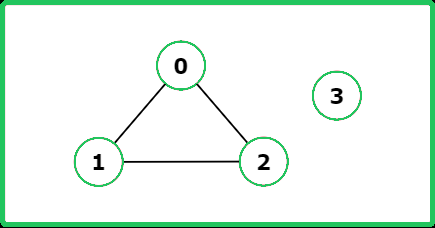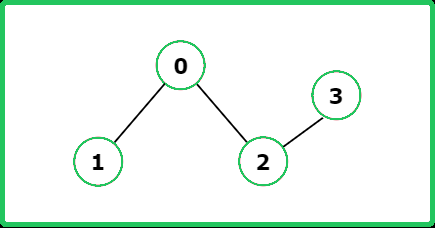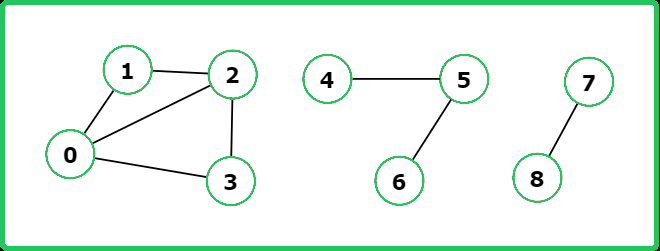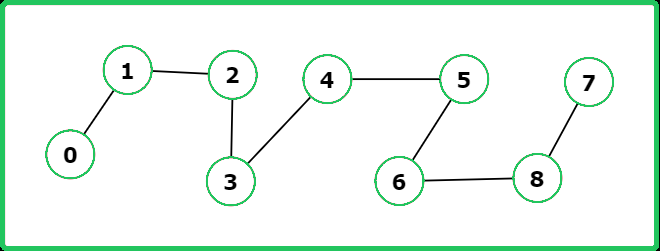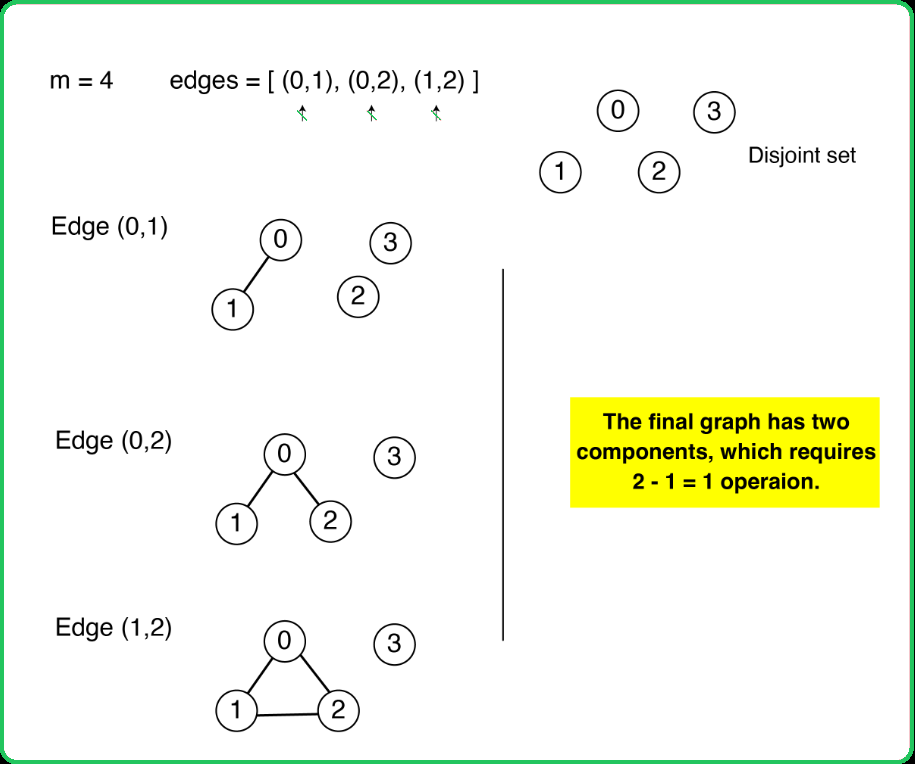123456789101112131415161718192021222324252627282930313233343536373839404142434445464748495051525354555657585960616263646566676869707172737475767778798081828384858687888990919293949596979899100101102103104105106107108109110111112113114115116
#include <bits/stdc++.h>
using namespace std;
class DisjointSet {
public:
/* To store the ranks, parents and
sizes of different set of vertices */
vector<int> rank, parent, size;
// Constructor
DisjointSet(int n) {
rank.resize(n + 1, 0);
parent.resize(n + 1);
size.resize(n + 1);
for (int i = 0; i <= n; i++) {
parent[i] = i;
size[i] = 1;
}
}
// Function to find ultimate parent
int findUPar(int node) {
if (node == parent[node])
return node;
return parent[node] = findUPar(parent[node]);
}
// Function to implement union by rank
void unionByRank(int u, int v) {
int ulp_u = findUPar(u);
int ulp_v = findUPar(v);
if (ulp_u == ulp_v) return;
if (rank[ulp_u] < rank[ulp_v]) {
parent[ulp_u] = ulp_v;
}
else if (rank[ulp_v] < rank[ulp_u]) {
parent[ulp_v] = ulp_u;
}
else {
parent[ulp_v] = ulp_u;
rank[ulp_u]++;
}
}
// Function to implement union by size
void unionBySize(int u, int v) {
int ulp_u = findUPar(u);
int ulp_v = findUPar(v);
if (ulp_u == ulp_v) return;
if (size[ulp_u] < size[ulp_v]) {
parent[ulp_u] = ulp_v;
size[ulp_v] += size[ulp_u];
}
else {
parent[ulp_v] = ulp_u;
size[ulp_u] += size[ulp_v];
}
}
};
// Solution class
class Solution{
public:
/* Function to get the number of
operations to make network connected */
int solve(int n, vector<vector<int>> &Edge){
// Get the number of edges
int size = Edge.size();
/* Return -1 if connecting all
vertices is not possible */
if(size < n-1) return -1;
// Disjoint Set data structure
DisjointSet ds(n);
// Add all the edges in the set
for(int i=0; i<size; i++) {
ds.unionByRank(Edge[i][0], Edge[i][1]);
}
// To store count of required edges
int count = 0;
// Finding the number of components
for(int i=0; i<n; i++) {
if(ds.parent[i] == i) count++;
}
// Return the result
return count-1;
}
};
int main() {
int n = 4;
vector<vector<int>> Edge = {
{0, 1},
{0, 2},
{1, 2}
};
// Creating instance of Solution class
Solution sol;
/* Function call to get the number of
operations to make network connected */
int ans = sol.solve(n, Edge);
cout << "The number of operations to make network connected is: " << ans;
return 0;
}
123456789101112131415161718192021222324252627282930313233343536373839404142434445464748495051525354555657585960616263646566676869707172737475767778798081828384858687888990919293949596979899100101102103104105106107108109110111
import java.util.*;
class DisjointSet {
/* To store the ranks, parents and
sizes of different set of vertices */
int[] rank, parent, size;
// Constructor
DisjointSet(int n) {
rank = new int[n + 1];
parent = new int[n + 1];
size = new int[n + 1];
for (int i = 0; i <= n; i++) {
parent[i] = i;
size[i] = 1;
}
}
// Function to find ultimate parent
int findUPar(int node) {
if (node == parent[node])
return node;
return parent[node] = findUPar(parent[node]);
}
// Function to implement union by rank
void unionByRank(int u, int v) {
int ulp_u = findUPar(u);
int ulp_v = findUPar(v);
if (ulp_u == ulp_v) return;
if (rank[ulp_u] < rank[ulp_v]) {
parent[ulp_u] = ulp_v;
}
else if (rank[ulp_v] < rank[ulp_u]) {
parent[ulp_v] = ulp_u;
}
else {
parent[ulp_v] = ulp_u;
rank[ulp_u]++;
}
}
// Function to implement union by size
void unionBySize(int u, int v) {
int ulp_u = findUPar(u);
int ulp_v = findUPar(v);
if (ulp_u == ulp_v) return;
if (size[ulp_u] < size[ulp_v]) {
parent[ulp_u] = ulp_v;
size[ulp_v] += size[ulp_u];
}
else {
parent[ulp_v] = ulp_u;
size[ulp_u] += size[ulp_v];
}
}
}
// Solution class
class Solution{
/* Function to get the number of
operations to make network connected */
public int solve(int n, int[][] Edge){
// Get the number of edges
int size = Edge.length;
/* Return -1 if connecting all
vertices is not possible */
if(size < n-1) return -1;
// Disjoint Set data structure
DisjointSet ds = new DisjointSet(n);
// Add all the edges in the set
for(int i=0; i<size; i++) {
ds.unionByRank(Edge[i][0], Edge[i][1]);
}
// To store count of required edges
int count = 0;
// Finding the number of components
for(int i=0; i<n; i++) {
if(ds.parent[i] == i) count++;
}
// Return the result
return count-1;
}
public static void main(String[] args) {
int n = 4;
int[][] Edge = {
{0, 1},
{0, 2},
{1, 2}
};
// Creating instance of Solution class
Solution sol = new Solution();
/* Function call to get the number of
operations to make network connected */
int ans = sol.Solve(n, Edge);
System.out.println("The number of operations to make network connected is: " + ans);
}
}
123456789101112131415161718192021222324252627282930313233343536373839404142434445464748495051525354555657585960616263646566676869707172737475767778798081828384858687888990
class DisjointSet:
# To store the ranks, parents and
# sizes of different set of vertices
def __init__(self, n):
self.rank = [0] * (n + 1)
self.parent = [i for i in range(n + 1)]
self.size = [1] * (n + 1)
# Function to find ultimate parent
def findUPar(self, node):
if node == self.parent[node]:
return node
self.parent[node] = self.findUPar(self.parent[node])
return self.parent[node]
# Function to implement union by rank
def unionByRank(self, u, v):
ulp_u = self.findUPar(u)
ulp_v = self.findUPar(v)
if ulp_u == ulp_v:
return
if self.rank[ulp_u] < self.rank[ulp_v]:
self.parent[ulp_u] = ulp_v
elif self.rank[ulp_v] < self.rank[ulp_u]:
self.parent[ulp_v] = ulp_u
else:
self.parent[ulp_v] = ulp_u
self.rank[ulp_u] += 1
# Function to implement union by size
def unionBySize(self, u, v):
ulp_u = self.findUPar(u)
ulp_v = self.findUPar(v)
if ulp_u == ulp_v:
return
if self.size[ulp_u] < self.size[ulp_v]:
self.parent[ulp_u] = ulp_v
self.size[ulp_v] += self.size[ulp_u]
else:
self.parent[ulp_v] = ulp_u
self.size[ulp_u] += self.size[ulp_v]
# Solution class
class Solution:
# Function to get the number of
# operations to make network connected
def solve(self, n, Edge):
# Get the number of edges
size = len(Edge)
# Return -1 if connecting all
# vertices is not possible
if size < n - 1:
return -1
# Disjoint Set data structure
ds = DisjointSet(n)
# Add all the edges in the set
for i in range(size):
ds.unionByRank(Edge[i][0], Edge[i][1])
# To store count of required edges
count = 0
# Finding the number of components
for i in range(n):
if ds.parent[i] == i:
count += 1
# Return the result
return count - 1
# Creating instance of Solution class
sol = Solution()
# Function call to get the number of
# operations to make network connected
n = 4
Edge = [
[0, 1],
[0, 2],
[1, 2]
]
ans = sol.solve(n, Edge)
print("The number of operations to make network connected is:", ans)
123456789101112131415161718192021222324252627282930313233343536373839404142434445464748495051525354555657585960616263646566676869707172737475767778798081828384858687888990919293949596979899100101102103
class DisjointSet {
/* To store the ranks, parents and
sizes of different set of vertices */
constructor(n) {
this.rank = new Array(n + 1).fill(0);
this.parent = new Array(n + 1);
this.size = new Array(n + 1).fill(1);
for (let i = 0; i <= n; i++) {
this.parent[i] = i;
}
}
// Function to find ultimate parent
findUPar(node) {
if (node === this.parent[node])
return node;
return this.parent[node] =
this.findUPar(this.parent[node]);
}
// Function to implement union by rank
unionByRank(u, v) {
let ulp_u = this.findUPar(u);
let ulp_v = this.findUPar(v);
if (ulp_u === ulp_v) return;
if (this.rank[ulp_u] < this.rank[ulp_v]) {
this.parent[ulp_u] = ulp_v;
}
else if (this.rank[ulp_v] < this.rank[ulp_u]) {
this.parent[ulp_v] = ulp_u;
}
else {
this.parent[ulp_v] = ulp_u;
this.rank[ulp_u]++;
}
}
// Function to implement union by size
unionBySize(u, v) {
let ulp_u = this.findUPar(u);
let ulp_v = this.findUPar(v);
if (ulp_u === ulp_v) return;
if (this.size[ulp_u] < this.size[ulp_v]) {
this.parent[ulp_u] = ulp_v;
this.size[ulp_v] += this.size[ulp_u];
}
else {
this.parent[ulp_v] = ulp_u;
this.size[ulp_u] += this.size[ulp_v];
}
}
}
// Solution class
class Solution {
/* Function to get the number of
operations to make network connected */
solve(n, Edge) {
// Get the number of edges
const size = Edge.length;
/* Return -1 if connecting all
vertices is not possible */
if (size < n - 1) return -1;
// Disjoint Set data structure
const ds = new DisjointSet(n);
// Add all the edges in the set
for (let i = 0; i < size; i++) {
ds.unionByRank(Edge[i][0], Edge[i][1]);
}
// To store count of required edges
let count = 0;
// Finding the number of components
for (let i = 0; i < n; i++) {
if (ds.parent[i] === i) count++;
}
// Return the result
return count - 1;
}
}
// Creating instance of Solution class
const sol = new Solution();
/* Function call to get the number of
operations to make network connected */
const n = 4;
const Edge = [
[0, 1],
[0, 2],
[1, 2]
];
const ans = sol.solve(n, Edge);
console.log("The number of operations to make network connected is:", ans);
